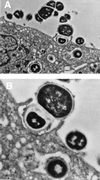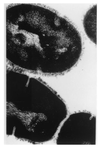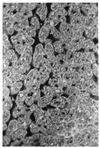Pathogenesis of group A streptococcal infections
- PMID: 10885988
- PMCID: PMC88944
- DOI: 10.1128/CMR.13.3.470
Pathogenesis of group A streptococcal infections
Abstract
Group A streptococci are model extracellular gram-positive pathogens responsible for pharyngitis, impetigo, rheumatic fever, and acute glomerulonephritis. A resurgence of invasive streptococcal diseases and rheumatic fever has appeared in outbreaks over the past 10 years, with a predominant M1 serotype as well as others identified with the outbreaks. emm (M protein) gene sequencing has changed serotyping, and new virulence genes and new virulence regulatory networks have been defined. The emm gene superfamily has expanded to include antiphagocytic molecules and immunoglobulin-binding proteins with common structural features. At least nine superantigens have been characterized, all of which may contribute to toxic streptococcal syndrome. An emerging theme is the dichotomy between skin and throat strains in their epidemiology and genetic makeup. Eleven adhesins have been reported, and surface plasmin-binding proteins have been defined. The strong resistance of the group A streptococcus to phagocytosis is related to factor H and fibrinogen binding by M protein and to disarming complement component C5a by the C5a peptidase. Molecular mimicry appears to play a role in autoimmune mechanisms involved in rheumatic fever, while nephritis strain-associated proteins may lead to immune-mediated acute glomerulonephritis. Vaccine strategies have focused on recombinant M protein and C5a peptidase vaccines, and mucosal vaccine delivery systems are under investigation.
Figures











References
-
- Adderson E E, Shikhman A R, Ward K E, Cunningham M W. Molecular analysis of polyreactive monoclonal antibodies from rheumatic carditis: human anti-N-acetyl-glucosamine/anti-myosin antibody V region genes. J Immunol. 1998;161:2020–2031. - PubMed
-
- Adrezejewski C, Jr, Rauch J, Stollar B D, Schwartz R S. Antigen binding diversity and idiotypic cross-reactions among hybridoma autoantibodies to DNA. J Immunol. 1980;126:226–231. - PubMed
-
- Ahmed S, Ayoub E M. Severe, invasive group A streptococcal disease and toxic shock. Pediatr Ann. 1998;27:287–292. - PubMed
-
- Ahmed S, Ayoub E M, Scornik J C, Wang C-Y, She J-X. Poststreptococcal reactive arthritis: clinical characteristics and association with HLA-DR alleles. Arthritis Rheum. 1998;41:1096–1102. - PubMed
-
- Akerstrom B, Brodin T, Reis K, Bjorck L. Protein G: a powerful tool for binding and detection of monoclonal and polyclonal antibodies. J Immunol. 1985;135:2589–2592. - PubMed
Publication types
MeSH terms
Substances
Grants and funding
LinkOut - more resources
Full Text Sources
Other Literature Sources
Medical
Molecular Biology Databases
Miscellaneous

